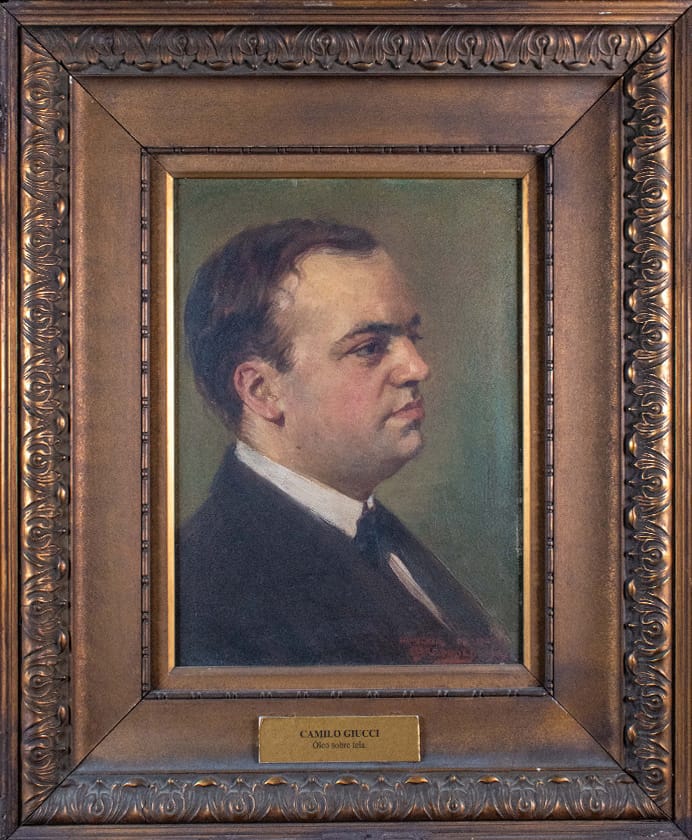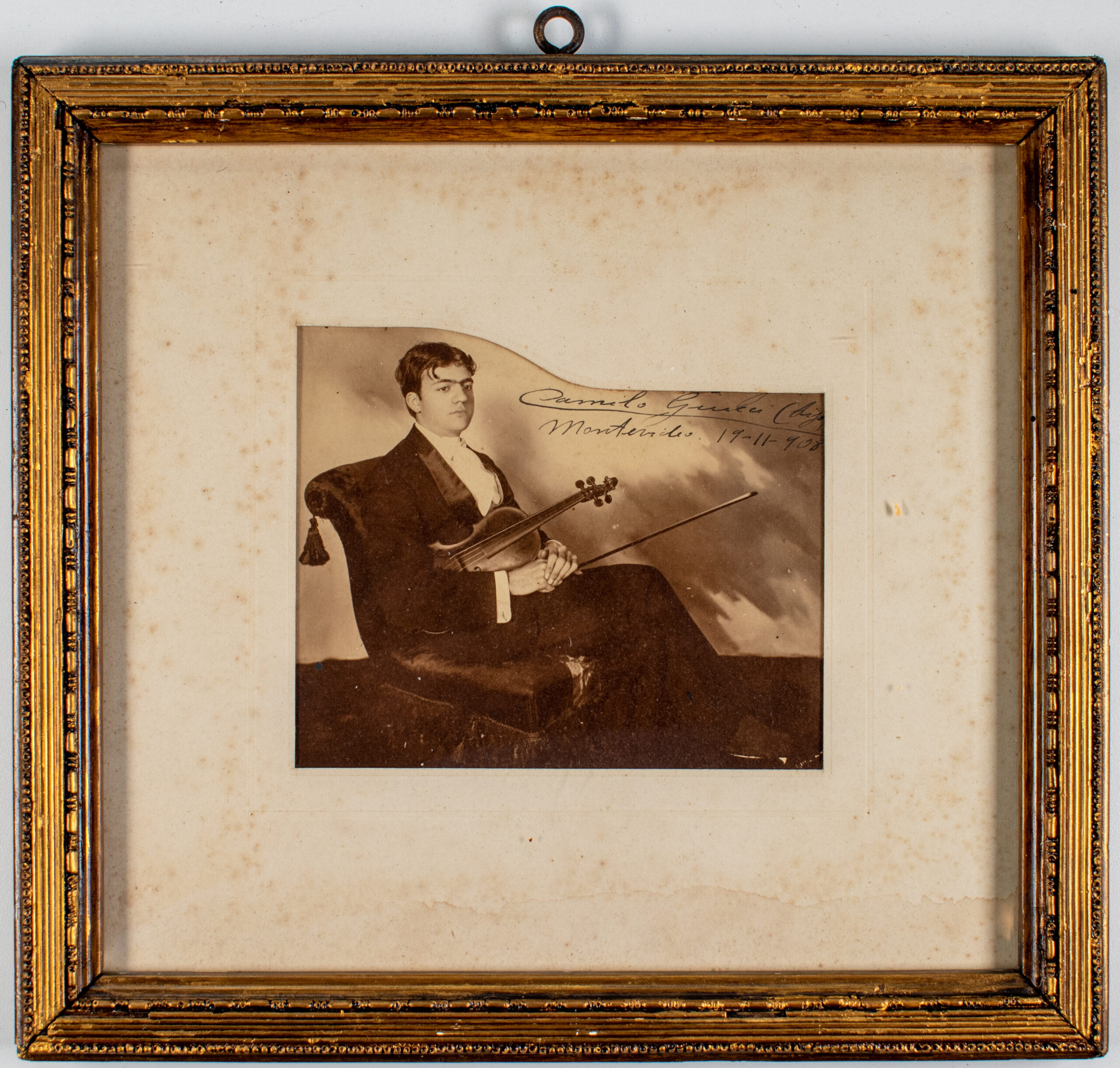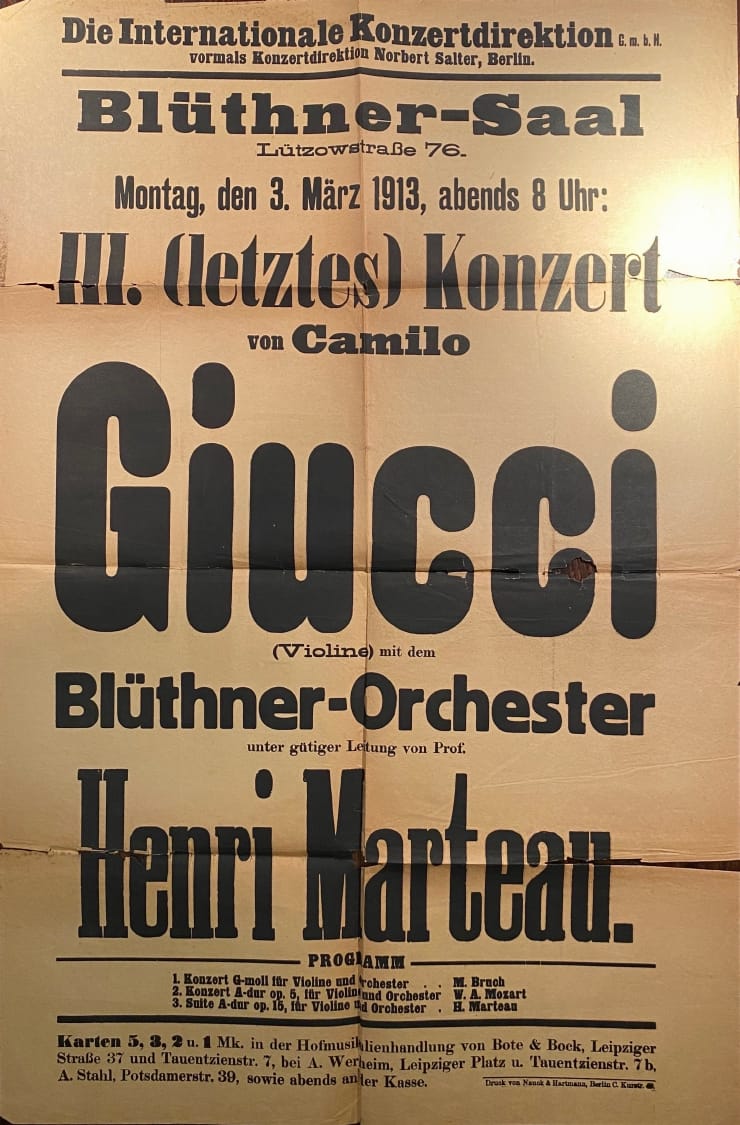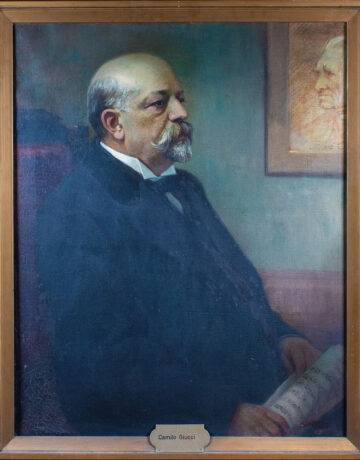Camilo Giucci was an Italian pianist, composer, and teacher who spent part of his life and artistic career in Uruguay, making a lasting impact on the Uruguayan musical environment.
The Giucci Family
Camilo Giucci Gallo
Camilo Giucci Gallo was a Uruguayan violinist and teacher. He was born in Montevideo on April 30, 1889. He was the eldest child of the marriage between Camilo Giucci and Luisa Gallo. Camilo began his violin studies at the age of 8 at the Franz Liszt Conservatory of Music with Virgilio Scarabelli. In 1897, he made his first public performance, in a concert at the Franz Liszt Conservatory of Music. On that occasion, his parents also performed, and Scarabelli conducted a small orchestra composed of students from the Conservatory of Music, which included Camilo. Throughout his childhood, he continued to perform in concerts on a regular basis. After one of them, the magazine Montevideo Musical stated: “As for the young Camilo Giucci, whom we had never before had the opportunity to hear on the violin, we were deeply impressed by the talent and intelligence he displayed.”
In 1907, Claudio Williman’s government enacted a scholarship law, which granted winners the opportunity to study in Europe. In November 1908 the contest was held, in which Camilo participated. As he wrote in an autobiographical text, the program consisted of Johann Sebastian Bach’s Sonata in G minor for solo violin, Henri Vieuxtemps’s Concerto in E major, Henryk Wieniawski’s Concerto in D minor, and finally, a sight-reading of a handwritten piece. The jury consisted of Virgilio Scarabelli, Luis Sambucetti (son), Tomás Giribaldi, León Ribeiro, Patricio Méndez Pérez and José Pedro Massera. Camilo was the winner of the contest, and was therefore awarded the scholarship.
Before leaving on his trip, he gave a farewell concert at the Teatro Solís, accompanied by the Argentine pianist Ernesto Drangosch. Thus, in 1909 he traveled to Germany, where he began his studies at the Royal Academy of Music in Berlin. In that city, he lived in the Massón family home. Adolfo Massón was a Uruguayan diplomat who knew the Giucci family. Camilo told his father that it was “a golden family; truly exceptional. I’m like a son to them, and have become completely like part of the family.” From correspondence with his family, it is clear that the Massón house was an important social center for Uruguayans living in Germany. In this regard, in January 1911 a dinner was held there in honor of José Batlle y Ordóñez and his family, who were in Berlin. Camilo played the violin and said in a letter that “Batlle sympathized with me enormously. He liked my playing and his wife was very enthusiastic, as were the children. In a word, they were left with a magnificent impression.”
During his stay in Germany, Camilo maintained his friendship with the Uruguayan composer César Cortinas, who had been a student of his father and was studying at the Royal Academy of Music in Berlin. During this period, Cortinas contracted tuberculosis and had to travel to Switzerland for medical treatment. The relationship between Camilo and Cortinas was marked by mutual admiration and shared musical interests. Thus, in a letter, Cortinas told him about his latest compositions, adding that “I was thinking of abandoning the Sonata, but since I see that you are fond of it, I will finish it and send it to you by April 14 or 15 at the latest. I think it is a work that is worthy of your bow (…).” During this period, Camilo wrote in a notebook an unpublished text entitled “Impresiones musicales. Lo que es y puede ser César Cortinas” (Musical Impressions. What César Cortinas is and can be), in which he praised his abilities, describing him as “a brilliant Uruguayan musician, the ideal type of born composer.”
As for Camilo’s apprenticeship in Berlin, he first studied with the Hungarian violinist and composer Carl Flesch. Camilo was very pleased to be able to study with Flesch, and told his father in a letter that “the mere fact of being a disciple of his is much more important than all the schools of music put together and any first prize of any conservatory.” He also stated that “Flesch is very happy with me, in the last lesson he gave me the 2nd certificate for my studies, and knowing how strict he is and how hard it is to meet Flesch’s expectations, this certificate is simply extraordinary.”
Between July and October 1910, he returned to Montevideo, taking advantage of the summer holidays in Germany. During this brief period, he gave concerts at the Franz Liszt Conservatory of Music and at the Teatro Urquiza. As recorded in the press, these concerts were favorably received by critics and audiences alike. Thus, an article published in El País stated that Camilo “seems destined to occupy, in the not so distant future, a leading position among contemporary concert artists, if he persists in this unwavering love for his studies.”
After his return to Germany, he began studying under the direction of the French violinist and composer Henri Marteau. In the first months of 1913, he gave a series of concerts in Berlin, accompanied by an orchestra conducted by Marteau. These concerts were highly praised by the critics, stating in one review that Camilo was “a young artist of very extraordinary qualities. The technique is complete and the sound is of a noble purity, without defects.”
In 1913, he returned to live permanently in Montevideo. After the passing of his father in December of that year, he took over the management of the Franz Liszt Conservatory of Music, a position he held until he passed away. In 1915 he abandoned his career as a concert pianist. According to an autobiographical text, this happened due to “a very serious nervous breakdown.” Since then, he did not appear in public again, devoting himself entirely to his role as a teacher and director of the Conservatory of Music. It is worth mentioning that his teaching role was not restricted to the Conservatory, since he held the violin chair at the National Conservatory, after its successive foundations in 1942 and 1954. Regarding his profile as a teacher, it is fascinating to find an unpublished manuscript, in which Camilo outlined a series of tips for learning the violin.
In turn, Camilo played an important role in the institutional development of the Conservatory of Music. During his tenure, the Conservatory continued to be a benchmark in the field of music education, as well as a key element in Montevideo’s cultural life, thanks to its organization of concerts and musical evenings. On the other hand, it should be noted that the Conservatory of Music sought to expand its area of action. Thus, branches were created throughout the country, in locations such as San José, Lavalleja, Maldonado, Salto, Santa Lucía, Trinidad, and Santa Rosa.
Throughout his life, Camilo established relationships with various figures in the music industry. His correspondence reveals links with the Argentine pianist Ernesto Drangosch, the Portuguese composer and pianist José Vianna da Motta, the Polish pianist Arthur Rubinstein, and the Austrian composer Kurt Pahlen.
Camilo Giucci passed away on January 7, 1973. His passing impacted the cultural environment and the press. Thus, the newspaper Última Hora stated that “national music is in mourning,” while highlighting Camilo’s importance as “one of the leading figures in the Uruguayan musical scene—a scene that without his presence, might never have reached the level of importance and prestige it enjoys today, even beyond national borders.”
The Giucci Family
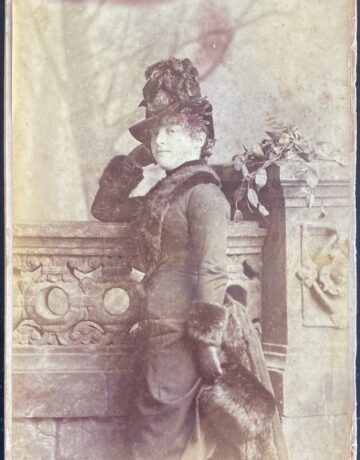
Luisa Gallo de Giucci
Luisa Gallo was a Uruguayan pianist and teacher.
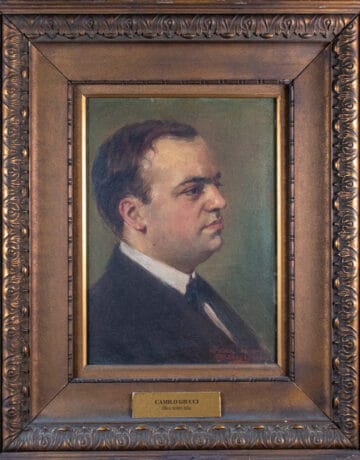
Camilo Giucci (son)
Camilo Giucci Gallo was a Uruguayan violinist and teacher.

